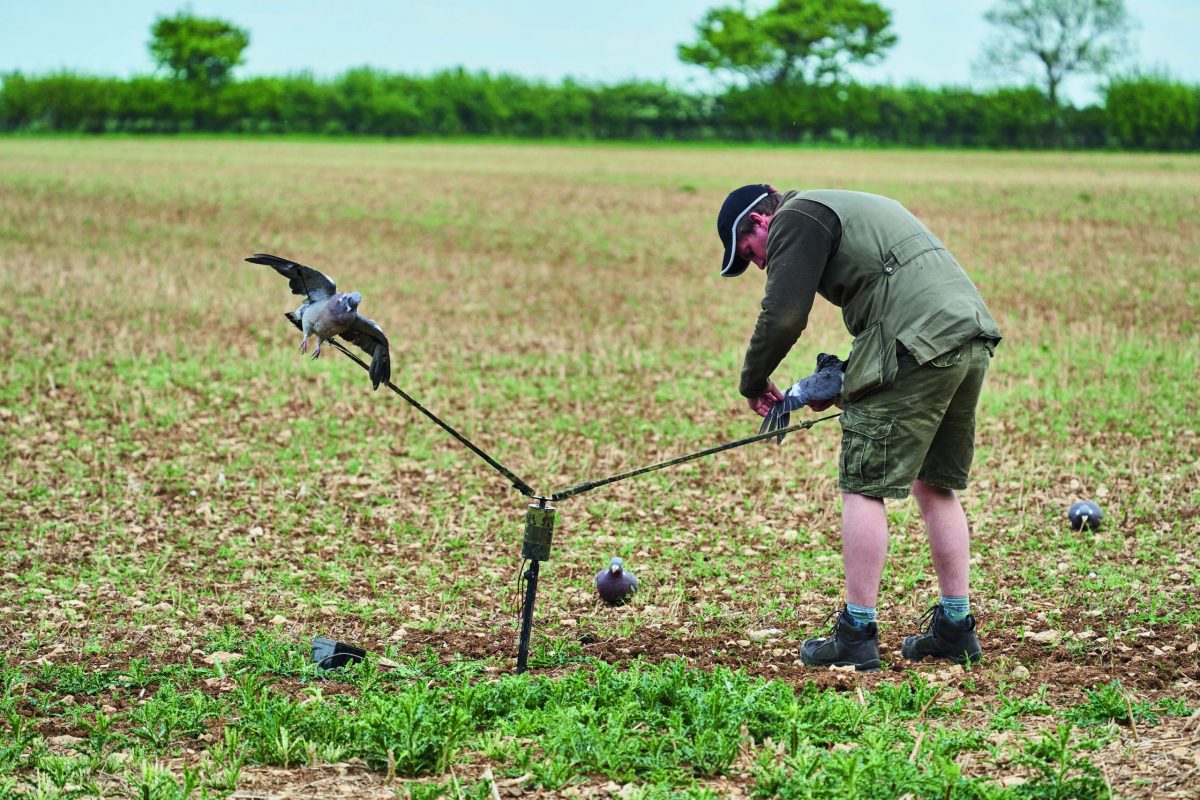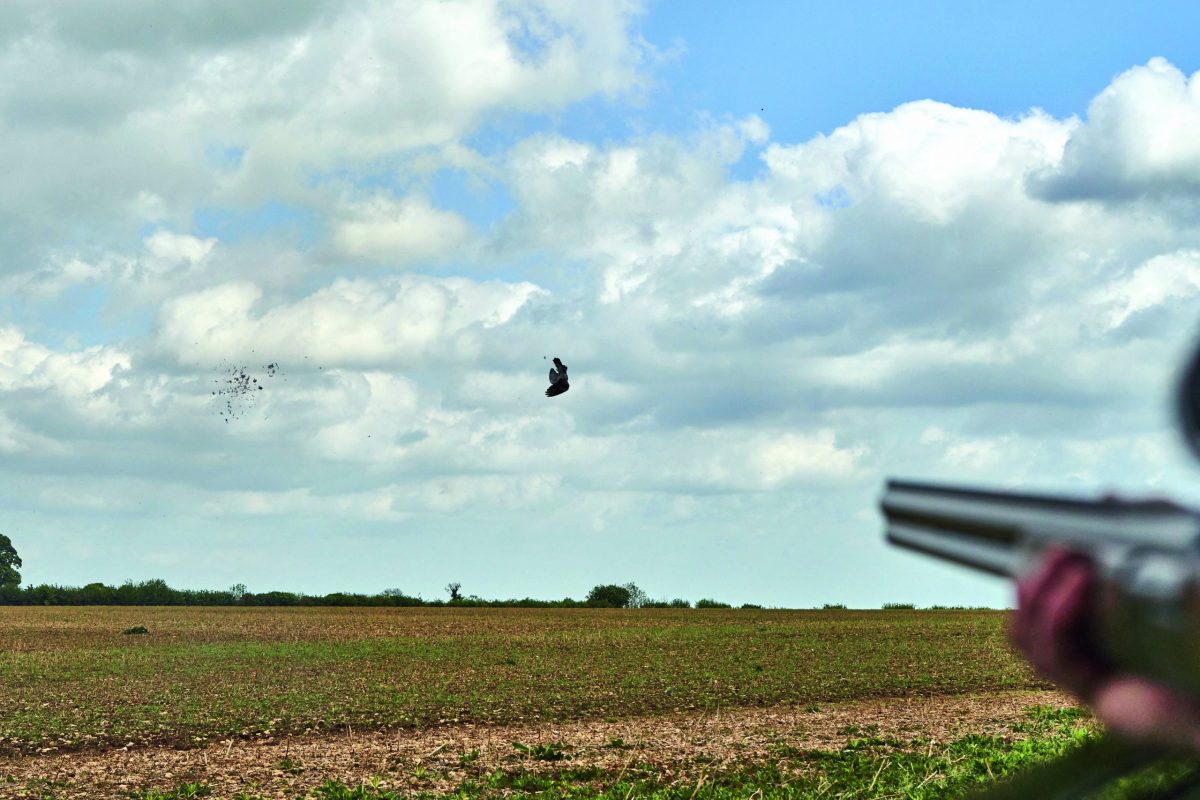Finally back out after his injury, Tom Payne muses on how to lure in his beloved birds when they have ‘restaurants’ everywhere
I won’t keep on about my jaw injury, but it feels like months since I fell out of that ash tree. I was recently speaking to a friend, who is an ex-England rugby player, about injuries. He was absolutely right when he said it will feel like eternity to me and to everyone else like not long at all. I can’t remember the last time I’ve gone so long without firing a shot.
Enough of me whining and back to the pigeon shooting. I finally got the all-clear a little over a week ago. OK, that’s not entirely true, but I felt sound, so I decided to trust myself; with my O level in biology, I feel qualified to make such calls. As I stepped into the hide, I was full of excitement. I’ve heard it said that it’s worth losing things just so you can find them again, but as the first bird approached the young peas in the shimmering sun, my excitement turned to fear.
People talk about the mental side of injuries and it does have an effect, but you simply have to get back on that horse. As I mounted the gun nothing felt quite right. To an outsider, everything probably would have seemed perfect, but I didn’t feel 100% committed. Scared, I suppose, is the best way to describe it. I’m a professional Shot, gunfitter and instructor and the thought of it all being taken away because of an injury is frightening.

Tom Payne adjusts the decoys he’s placed in cradles
Competition
May isn’t an easy time to get back in the saddle. It’s the toughest time of year to manage pigeons. If you’re lucky, crops such as peas, spring rape, lucerne, failed rape or grazed clover are all good bets, but you will competing against wild food sources, tree buds in particular. It’s a fantastic time of year to test your skills. Reconnaissance is difficult with everything so lush and green.
You really do have to think like a pigeon. Outings are few and far between but always well earned when they come.
It’s a great time of year but don’t expect big outings. It’s a time of year when you will need all your skills and to harvest a good number for the farmer is satisfying. Reconnaissance is key and you have to be patient with it. Just because you may not see the birds doesn’t mean they aren’t there. Warm afternoons with a light breeze are the perfect conditions to be out looking.

Tom uses two taller poles at the back of the hide to provide cover
It’s a good idea to go for a walk on your recon trips. Sometimes, quietly walking hedgerows, woodland edges and spinneys can give you an indication on what’s about. It’s worth quietly sitting down to watch the birds’ behaviour carefully. It’s fascinating how pigeons can switch on and off to different food sources and it’s common to find various food types in their crops at this time.
I always advise people to look in the pigeon’s crop. There’s no better indicator than that to give you an idea of what they’re eating. It’s no different to spooning a trout to get an idea of what fly life they’ve been feeding on.
Drifting in
My first trip back out was a perfect afternoon and birds gently drifted in. I’m sensible — well, sensible when it comes to shooting — and I didn’t get carried away. I shied away from the long shots I would usually be confident in taking and avoided many shots that were a bit short notice and caught me by surprise, mainly due
to lack of confidence.
I’d love to talk about some great action shots, but unfortunately I was pedestrian about the whole thing. It felt right. What could have been a comfortable 60-plus in a normal situation ended up being in the late 30s. It does make me realise how I get to big bags. Shooting numbers is all about making the most of every opportunity. On my first outing back I was a good 50% shy of what I should have been.
As many readers will be aware, I’m a new father. With this comes responsibilities — if my partner Claire wants to have a shot, I have to pick up Junior from nursery. As I sat there plugging away, I thought about all the pigeon shooting skills that I will teach Monty one day. Perhaps the first of them will be hide building. Crop identification isn’t much fun if you’re three years old, but building a hide is really only building a den, which toddlers adore.

Tom adds the first two shot pigeons to his magnet spinner to give the pattern height and movement
First is the correct location of the hide, second is its ability to blend in. How you choose to build your hide, what nets you use and how you brash it up all depend on the time of year, what the surrounding foliage is like and the part of the country. I mention this last because in some areas where pigeons are green, you could sit out in the open with a single hazel branch as a ‘hide’. In other areas where birds have been pestered, you need to be more canny.
Pigeon shooting equipment is, as I’ve said many times, not great these days. I believe most stealth nets and flimsy telescopic poles are a con. I’ve used a lot of these things and most of them are horrendous. The stealth nets shine and it makes me cringe when I see people using them. You can’t beat old-school army nets, but they’re difficult to come by.
My old home-made poles are brilliant and Nick Tait from Flightline Decoys has made some called sniper poles. That sounds like a plug, but I promise you they are superb.
Making a decent hide is fairly straightforward, and I rely on some simple principles: location, colour, shape and size. Location is paramount and is down to your recon. If you get this key factor wrong, you’ve already failed. Put up a hide even slightly in the wrong place and you’ve had it. Your hide placement must be located where the birds want to feed on the chosen crop. Wind is another key factor. Ideally you want the wind off your back or a crosswind.
On many occasions I make my hide in the field. It pays to be brave; never think because you don’t have a nice hedge behind you that placing a hide in the field won’t work. It’s how you build the hide that’s vital.
The colour of the hide is important too. This is governed by the foliage around you and the crop you are on. Rural Britain is made up of many colours, so dark green nets can often look black and blocky. Mix it up. I use various nets in most situations at most times of the year. Brashing your hide is essential if birds are wary — it really makes the hide blend in — but it isn’t always necessary.
I was sent the new Nitehawk gillie nets and so far I’ve been quite impressed. They remind me of the old hessian nets I used as a youngster. First impressions are great, but I need to use them for a year before I can really comment.

Tom feels he could have shot a bigger bag but he’s taking things steadily
Building a hide that is too blocky can be an error in some situations; leaving gaps and holes can actually be of benefit. It allows natural cover to come through.
The shape of your hide is another important factor. I always use eight poles and make my hides circular as this reduces any hard edges. You don’t want it to be a dark, square box. The trailer hide I use sometimes gets away with it because we use hessian on the outside, which makes it look like a bale. The trailer hide is only
deployed in certain situations, and I prefer a natural hide with nets in many cases.
You must remember that birds can look in, so the height you set the hide is important. You want to be able to look through the hide for arriving birds, not over it. Size is a very important aspect, mainly from a shooting point of view. You need to have space to allow you to shoot to the best of your ability. Footwork and body position are key if you want to shoot well. Small, cramped hides are no good as they are restrictive. The size and location of the hide should allow you to maximise your angles. You must also make sure that your hide discipline and the way you move in the hide doesn’t draw attention to arriving birds.
Lastly, don’t be lazy. Read the situation and place your hide correctly, making sure you effectively blend in and disappear. If your hide stands out to you, it will stand out to the birds and, believe me, their eyesight is much keener than ours.

The pigeons start to come in, some in pairs, some singles and a few in gangs
Tail-enders
Back in my hide, the birds were gently coming in, singles and pairs, with a few gangs that headed up the hedgerow to my left. The front of the gang would be drawn to an ash tree but fortunately more often than not the tail-enders would resist the tree and head to the decoys.
It was almost time to pick up my son Monty. Would his nursery teachers understand why I was late? Probably not. It was only his second day. As Claire walked across the field to take my place, the time had come. I did get him back for the clear-up and a bit of spectating from a distance. What a babyhood he’s having.




